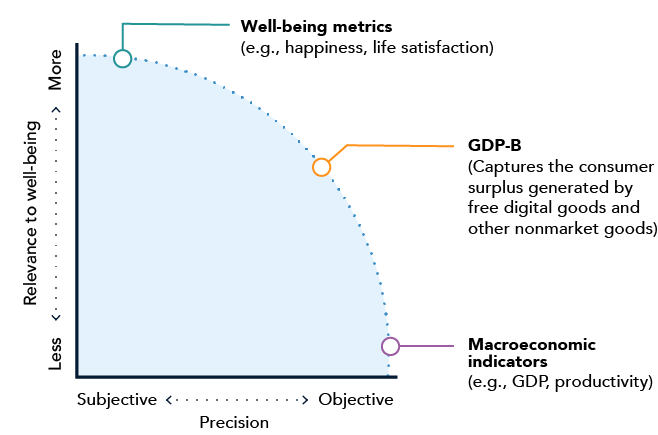Gross Domestic Product, or GDP, is the sum of the value of all goods and services produced in a country in one year, where price is a proxy for value. Developed in the 1930s and reported quarterly, GDP remains the dominant metric economists and policymakers look to for analyzing the health of our economy and setting economic policy.
Yet GDP fails to measure well-being in the digital economy. As more and more of our economy is driven by digital rather than physical goods, by bits rather than atoms, traditional methods used to measure the economy are no longer accurate.

Simon Kuznets

Robert Kennedy

Joseph Stiglitz
As more and more of our economy is driven by digital rather than physical goods, traditional methods used to measure the economy are no longer accurate. We need a better method of measuring the health and progress of the AI-powered economy in order to build a tech-driven society that benefits everyone.
GDP-B (the ‘B’ stands for benefits) measures how much consumers benefit from goods and services, not just how much they pay. Our approach starts from basic principles of economics: changes in well-being stem from changes in the economic surplus created by goods and services, rather than the money spent on them.
Our goal is to transform economic measurement for the digital age with a novel, reliable, and replicable set of metrics for changes in welfare. Digital platforms, fine-grained data, and machine learning allow us to better account for several dimensions of people’s welfare and measure the value of digital goods as they change over time.

In practice, our team uses massive online choice experiments to measure the consumer surplus from free digital goods not captured by traditional economic statistics. We can also apply GDP-B to other areas of the economy, including household production, government services, and changes in health, environmental, and social indicators.
Our vision is to transform economic measurement for the digital age with a reliable and replicable set of metrics for changes in wellbeing. GDP-B can also be applied to other areas of the economy, including household production, government services, and changes in health, environmental, and social indicators.



The anticipated three-year timeline includes experiments, scaling, and convenings that allow us to measure more goods, more frequently over time.

Current supporters of the GDP-B project include:
National Science Foundation – NSF’s mission is to advance the progress of science, a mission accomplished by funding proposals for research and education.
Project Liberty – Project Liberty is stitching together an ecosystem of technologists, academics, policymakers and citizens committed to building a better internet—where the data is ours to manage, the platforms are ours to govern, and the power is ours to reclaim.
Our research is powered by access to top research talent, survey resources, and collaborations. The anticipated three-year timeline includes experiments, scaling, and convenings that allow us to measure more goods, more frequently over time.
Join us in our mission to advance our collective understanding of the digital economy. Learn how to be part of the GDP-B project by emailing digitaleconomylab@stanford.edu.



